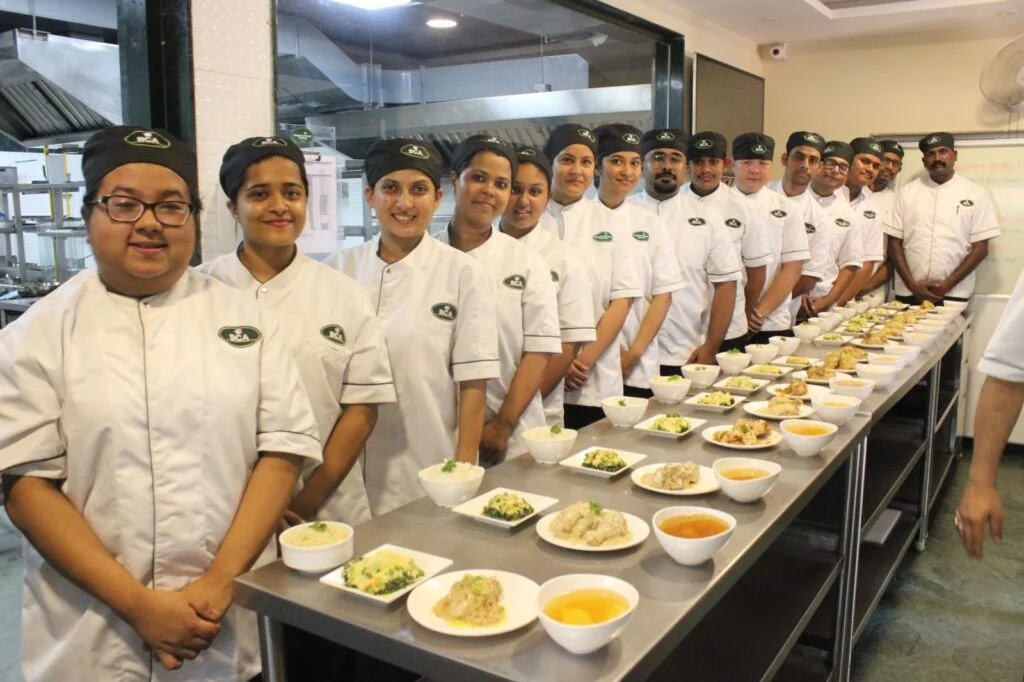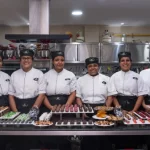
Exponential Growth in the Hospitality Sector
India’s hospitality sector is growing not only in size but in terms of quality as well. New hotels and restaurants are coming up across the country, providing more than mere food and accommodation. Today’s hospitality companies are based on innovative ideas and consumer experiences. The business is changing rapidly from sustainability to artisanal menus to cultural cuisine, so effective chef training is more essential than ever. A diploma from a well-known culinary academy provides up-and-coming chefs with the skills they need to succeed in this competitive environment. These chef courses equip students with real-world kitchen requirements while giving access to thrilling career opportunities.
Most importantly, this expansion is observable not only in major cities but also in the regions outside Bangalore. In the vicinity of Hebbal, where Bangalore Culinary Academy is situated, there has been a discernible increase in new restaurants, cafés, and high-end hotels. Global chains such as Courtyard Marriott, Radisson Blu, and Hyatt have all made their mark there, with offerings suited to changing local tastes. This surge in development is spurring on a wider, more diverse culinary universe, offering genuine prospects for graduates trained by local culinary institutes to excel both in local hospitality environments and within international settings.
What are the implications for future chefs?
It means unparalleled career flexibility. Whether it’s leading an R&D kitchen for a plant-based company in Bangalore, starting up a farm-to-table bistro in Goa, or learning with Michelin-starred chefs at a five-star hotel in Delhi, there’s space for each gastronomic aspiration. The scene is fertile with innovation, mentorship, and entrepreneurship.
For aspiring students entering this vibrant profession, joining professional chef training courses at a well-established culinary school does more than prepare them for the workplace—it positions them at the forefront of a dynamic cultural and economic revolution redefining hospitality in India and the world at large.
Demand for Skilled Culinary Professionals
The sudden boom of India’s hospitality industry has come with its toll: a dire need for skilled culinary chefs who can keep pace with the changing requirements of contemporary kitchens. Despite having state-of-the-art infrastructure and concept-oriented hospitality venues, most are still forced to resort to untrained manpower. Though these professionals may be diligent in their work, their careers focus on dull, repetitive tasks devoid of creativity and promotional opportunities. All this increased chasm has illustrated is how severely the professional skills of a talented culinary chef who can not only provide proficiency but also innovatively contribute are missed.
This reactive approach—training unskilled manpower on the job—may keep operations afloat, but it ultimately stifles creativity, consistency, and quality. What the industry truly needs is a new generation of trained chefs who are not only technically adept but also attuned to global culinary standards, sustainability practices, and strategic kitchen management.
A diploma in culinary arts is not just a skill certification; it’s an investment in creating professionals capable of leading, innovating, and raising the bar on dining. With intensive training, students develop mastery in food science, global cuisines, and operational effectiveness, rendering them extremely valuable assets in a talent-scarce industry. For hiring managers, recruiting a diploma holder is not merely a safer option—it’s a strategic step toward long-term excellence and competitiveness.



Value Proposition of Culinary Education
Culinary education, or a formal diploma in culinary arts, is not well understood as far as its real potential and long-term benefits are concerned. Most students draw parallels with more traditional career paths, like the aviation industry or corporate careers, without appreciating the distinct value a culinary diploma offers in the experience-based and interconnected economy of today.
In contrast to other careers with strict hierarchies and capped career development, the culinary career path values creativity, discipline, and innovation—traits developed through professional chef training at a reputable culinary academy. Such graduates from the chef courses depart with so much more than culinary kitchen skills. They acquire an in-depth appreciation of gastronomy, culinary trends, nutrition, kitchen economics, and people management.
An accepted culinary diploma provides a competitive advantage for individuals seeking to balance international exposure with individual satisfaction. It develops hard and soft skills—everything from team management and sustainable practices to menu planning and cultural awareness—characteristics in great demand in hospitality careers. Diploma holders, given proper training and perseverance, can easily advance from commis chefs to executive chefs, or even establish successful enterprises.
In essence, this isn’t just a course—it’s a launchpad. Whether you’re looking to work in Michelin-star kitchens, luxury resorts, or cutting-edge cloud kitchens, or even start your own brand, a diploma from a reputed culinary academy opens doors to every possibility. It nurtures personal brands and builds professionals ready to thrive under pressure, lead with purpose, and adapt to global culinary trends.
Career in Culinary Arts
In the culinary arts, growth is no accident—it’s deliberate, quantifiable, and steeped in possibility. Sure, it usually takes about three years to work one’s way up to a supervisory role, but this period is a compilation of not only technical proficiency-building, but also strategic positioning, mentorship, and brand-building.
In contrast to static positions in traditional industries, culinary professions are dynamic by nature. A diploma program provides the scaffolding for that development, not just teaching students kitchen expertise but also soft skills such as communication, crisis management, and pressure leadership. The capacity to lead a brigade, control food costs, adjust menus, and motivate junior staff is developed intentionally over time.
Additionally, career pathways are no longer straightforward. A graduate of a diploma course may be working alongside a Michelin-starred chef one year, designing private dining experiences the next, or consulting on a heritage revival project overseas. The range of experience that can be found in this profession is unmatched—and students who start with a solid academic and practical grounding are the ones best equipped to take advantage of these different opportunities.
Several of our graduates have gone through this fast-tracked journey. From leading pastry departments in high-end hotels to establishing their own artisanal businesses, their success stories are a testament to how formal education combined with industry exposure can quickly take one’s culinary journey to the next level.
Addressing Common Misconceptions about the Culinary Industry
Perhaps the most ubiquitous and harmful of these myths surrounding the culinary trade is that the work is poorly paid, brutally overworked, and lacking career stability. That being said, it is undoubtedly true that the industry requires discipline and intensity, as does any profession that pays dividends over time. The reality is that the culinary trade boasts unparalleled potential for advancement, artistry, and worldwide mobility.
First-entry wages in the food industry normally start between ₹18,000 to ₹24,000 per month—similar to most service-based sectors. That is only the starting point, though. True potential lies beyond: a skillfully mapped trajectory based on expertise, innovation, and strategy. With the right diploma, learners are positioned to fast-track it. Internships at top-of-the-line kitchens, guidance by industry legends, and practical training in live kitchen laboratories quickly propel expertise and salaries alike.
Why Choose a Diploma Over On-the-Job Training
Whereas on-the-job training does provide an inkling of what it’s like to be working in the kitchens, it lacks in creating an all-around culinary professional. Oftentimes, on-the-job training emphasizes performance rather than knowledge, doing it repeatedly rather than coming up with something new. A diploma course in culinary arts, however, is geared to create not only competent workers but also knowledgeable, flexible, and progressive chefs.
A professional culinary education puts students into the wider gastronomy ecosystem. It extends beyond knife proficiency and recipe memorization to include food anthropology, sustainability in procurement, molecular gastronomy, menu engineering, and the psychology of eating. Students learn how to think like culinary designers—crafting experiences, running kitchen businesses, and balancing creativity with profitability.
Furthermore, diploma programs in culinary develop critical soft skills such as team leadership, crisis management during busy service hours, and cross-cultural collaboration—most important for an industry that succeeds based on global influences. They graduate with the ability to step into international kitchens, articulate culinary visions with clarity, and take up roles requiring creative genius as well as managerial acumen.
In a world where borders between chef, entrepreneur, influencer, and innovator are dissolving, a diploma offers the basis to wear several hats with assurance. It’s not a qualification—it’s a metamorphosis.
In conclusion,
Following a Diploma in Culinary Arts is not just a stepping stone—it’s a leap of faith into a vibrant, high-potential career horizon defined by creativity, innovation, and global appeal. It’s a deliberate decision to marry passion with purpose, to adopt a craft that requires both artistry and precision, and to subscribe to excellence in an ever-evolving industry. A diploma offers the tools, mindset, and mentorship required to thrive in this demanding yet deeply rewarding environment.
Today more than ever—with India’s hospitality industry booming and global opportunities opening up—this is the time to invest not only in a career, but in a calling. For those willing to head the kitchens of the future, the journey starts here.

